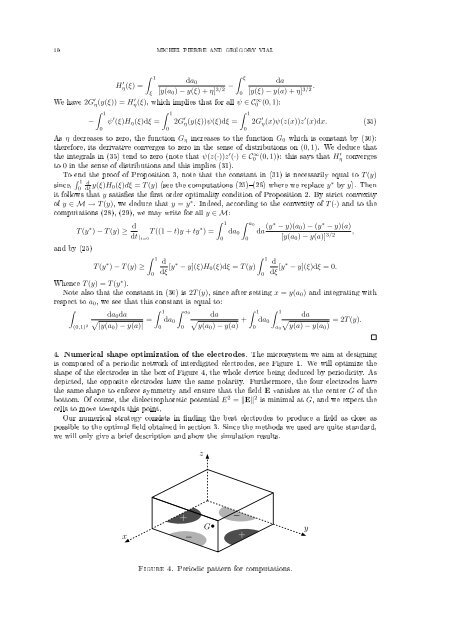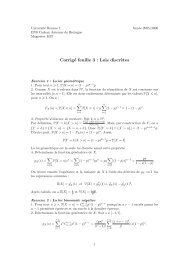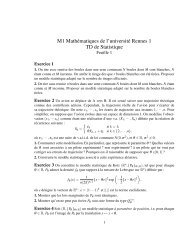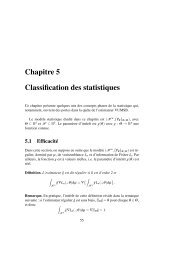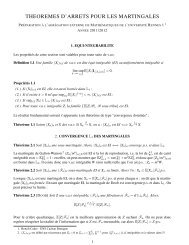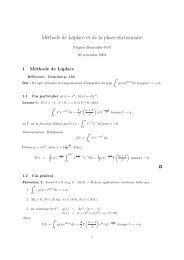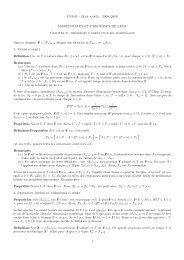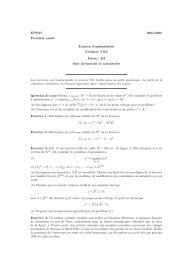10 MICHEL PIERRE AND GRÉGORY VIALH ′ η(ξ) =∫ 1ξ∫da ξ0[y(a 0 ) − y(ξ) + η] − da3/2 [y(ξ) − y(a) + η] . 3/2We have 2G ′ η(y(ξ)) = H ′ η(ξ), which implies that <strong>for</strong> all ψ ∈ C ∞ 0 (0, 1):−∫ 10ψ ′ (ξ)H η (ξ)dξ =∫ 102G ′ η(y(ξ))ψ(ξ)dξ =0∫ 102G ′ η(x)ψ(z(x))z ′ (x)dx. (35)As η <strong>de</strong>creases to zero, the function G η increases to the function G 0 which is constant by (30):there<strong>for</strong>e, its <strong>de</strong>rivative converges to zero in the sense of distributions on (0, 1). We <strong>de</strong>duce thatthe integrals in (35) tend to zero (note that ψ(z(·))z ′ (·) ∈ C0 ∞ (0, 1)): this says that H η ′ convergesto 0 in the sense of distributions and this implies (31).To end the proof of Proposition 3, note that the constant in (31) is necessarily equal to T (y)since, ∫ 1 d0 dξ y(ξ)H 0(ξ)dξ = T (y) (see the computations (25)(26) where we replace y ∗ by y). Thenit follows that y satises the rst or<strong>de</strong>r optimality condition of Proposition 2. By strict convexityof y ∈ M → T (y), we <strong>de</strong>duce that y = y ∗ . In<strong>de</strong>ed, according to the convexity of T (·) and to thecomputations (28), (29), we may write <strong>for</strong> all y ∈ M:T (y ∗ ) − T (y) ≥ d dt | t=0T ((1 − t)y + ty ∗ ) =∫ 10da 0∫ a00da (y∗ − y)(a 0 ) − (y ∗ − y)(a)[y(a 0 ) − y(a)] 3/2 ,and by (25)∫ 1∫T (y ∗ d1d) − T (y) ≥0 dξ [y∗ − y](ξ)H 0 (ξ)dξ = T (y)0 dξ [y∗ − y](ξ)dξ = 0.Whence T (y) = T (y ∗ ).Note also that the constant in (30) is 2T (y), since after setting x = y(a 0 ) and integrating withrespect to a 0 , we see that this constant is equal to:∫∫da 0 da1 ∫ a0∫√(0,1) 2 |y(a0 ) − y(a)| = da1 ∫ 1da 0 √0 y(a0 ) − y(a) + dada 0 √ = 2T (y).0 y(a) − y(a0 )0a 04. Numerical shape optimization of the electro<strong>de</strong>s. The microsystem we aim at <strong><strong>de</strong>sign</strong>ingis composed of a periodic network of interdigited electro<strong>de</strong>s, see Figure 1. We will optimize theshape of the electro<strong>de</strong>s in the box of Figure 4, the whole <strong>de</strong>vice being <strong>de</strong>duced by periodicity. As<strong>de</strong>picted, the opposite electro<strong>de</strong>s have the same polarity. Furthermore, the four electro<strong>de</strong>s havethe same shape to en<strong>for</strong>ce symmetry and ensure that the eld E vanishes at the center G of thebottom. Of course, the dielectrophoretic potential E 2 = ‖E‖ 2 is minimal at G, and we expect the<strong>cells</strong> to move towards this point.Our numerical strategy consists in nding the <strong>best</strong> electro<strong>de</strong>s to produce a eld as close aspossible to the optimal eld obtained in section 3. Since the methods we used are quite standard,we will only give a brief <strong>de</strong>scription and show the simulation results.zx+−G•−+yFigure 4. Periodic pattern <strong>for</strong> computations.
FASTEST CELLS SELECTING PROCESS 114.1. Computation of the electric eld <strong>for</strong> a given shape. Due to the periodicity conditionson the lateral si<strong>de</strong>s of the box, we use a <strong>de</strong>scription of the unknowns in terms of Fourier series.Precisely, the electric potential V is written asV (x, y, z) = ∑V k,l (z)e iω(kx+ly) , (36)k,l∈Zwith ω = 2π/L where L is the common edge-length in the x and y directions.The electro<strong>de</strong>s E ± are supposed to be innitely thin and are integrated through boundaryconditions on z = 0. Besi<strong>de</strong>s, it is not clear which boundary condition has to be imposed onthe top si<strong>de</strong> of the box, and it is more natural to consi<strong>de</strong>r a semi-innite beam with evanescentcondition at z → +∞. Altogether, the electric potential solves the following Laplace problem:⎧−∆V (x, y, z) = 0 <strong>for</strong> (x, y, z) ∈ [0, L] × [0, L] × [0, +∞),⎪⎨ V (x, y, 0) = ±V 0 <strong>for</strong> (x, y) ∈ E ± ,(37)∂ z V (x, y, 0) = 0 <strong>for</strong> (x, y) /∈ E ± ,⎪⎩V (x, y, z) → 0 as z → +∞.The coecients V k,l (z) are given byV k,l (z) = V k,l (0)e −ωz√ k 2 +l 2 ,so that problem (37) reduces to the following linear equation on the V k,l (0):∑V k,l (0)e iω(kx+ly) = ±V 0 <strong>for</strong> (x, y) ∈ E ± ,k,l∈Z∑k,l∈ZV k,l (0) √ k 2 + l 2 e iω(kx+ly) = 0 <strong>for</strong> (x, y) /∈ E ± .If the discretization incorporates N Fourier frequencies, a collocation method leads to a full N × Nlinear system. The electric potential V is reconstructed via inverse fast Fourier trans<strong>for</strong>m, as wellas the electric eldE = −∇V.4.2. Least square optimization. The optimal electric eld being <strong>de</strong>termined according to Section3, we now <strong><strong>de</strong>sign</strong> the electro<strong>de</strong>s to produce the closest eld in a least square sense. Asmentioned above, we <strong>for</strong>ce the electro<strong>de</strong>s to be i<strong>de</strong>ntical (another symmetry axis is also imposed inthe computations below). We start from circular shapes which were already consi<strong>de</strong>red to be the<strong>best</strong> shapes from an experimental point of view, among those consi<strong>de</strong>red in [4]. Then, we apply a<strong>de</strong>scent method <strong>for</strong> the optimization criterion:∫Find E minimizing ‖E − E ∗ ‖ 2 = (E − E ∗ ) 2 (x, y)dxdy, (38)where the target eld E ∗ is given in Section 3 and where Ω is a region of interest around the originin the horizontal section z = 1/30 which corresponds to experimental initial positions of the <strong>cells</strong>(note that choosing the whole box <strong>for</strong> Ω would not be very relevant since the eld produced byplanar electro<strong>de</strong>s does certainly have a completely non-radial structure).The electro<strong>de</strong>s are represented by a spline interpolation of control points. Figure 5 shows theelectro<strong>de</strong>s obtained with 5 such points after the optimization <strong>process</strong> (the procedure consists ina periodic relaxation among boundary <strong>de</strong><strong>for</strong>mations of the electro<strong>de</strong>s along the normal vector ateach control point).We may compare the average time of a particle to reach the minimum of the eld <strong>for</strong> the twosituations of Figure 5. A Monte-Carlo method coupled with the numerical resolution of the ordinarydierential equation (2) attests a gain of about 20% with respect to the <strong>best</strong> knows shapes see [4].Finally, let us mention that we also applied our optimization algorithm by replacing the leastsquareobjective (38) by the average numerical reaching time. The obtained electro<strong>de</strong>s are similarto those of Figure 5, with comparable optimal reaching times.Acknowledgements : We thank Bruno LePioue and Marie Frénéa-Robin <strong>for</strong> having suggestedthis nice problem, and Martin Costabel <strong>for</strong> fruitful discussions around it.Ω


